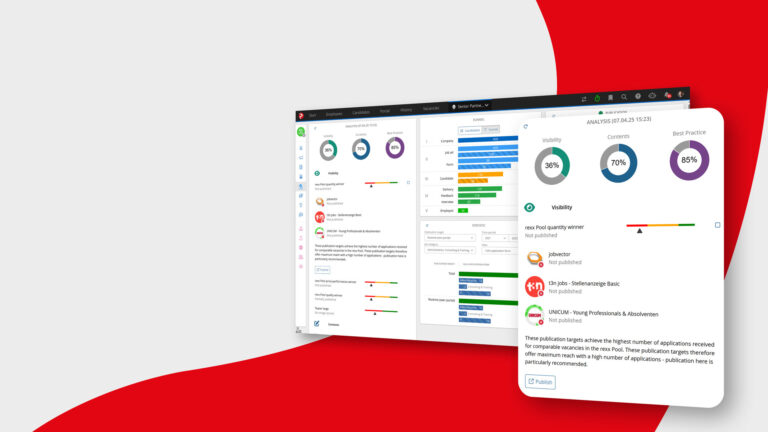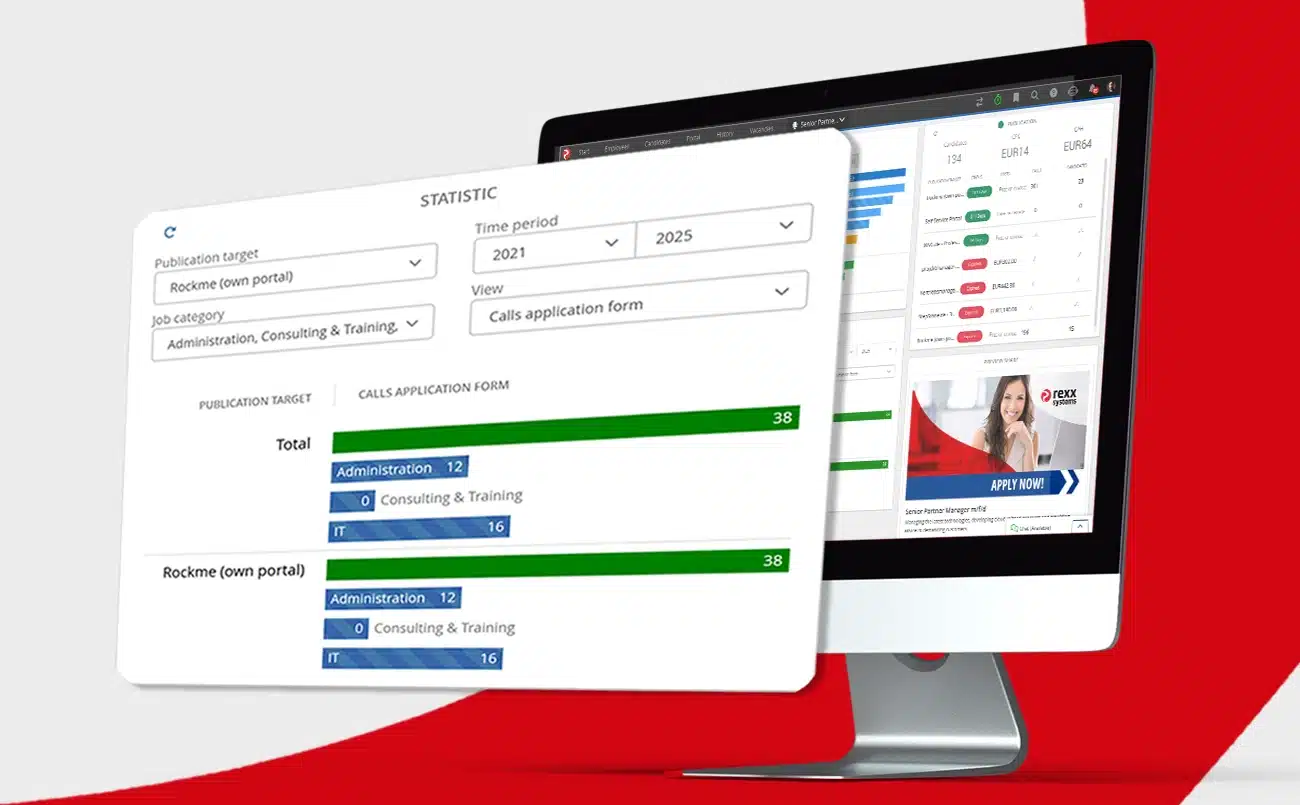All recruiting key figures and optimisation options at a glance.

Recruiting key figures with the Rexx vacancy analysis
The Rexx vacancy analysis delivers reliable recruiting key figures thanks to the combination of big data, artificial intelligence and decades of experience.
This feature is the game changer for your job adverts and brings you high-quality candidates. You receive targeted support in the creation and publication of your adverts, taking them to a new level.
In-depth data analysis and AI-supported optimisation set this function apart from conventional recruiting solutions. It integrates seamlessly into the system, from the job advertisement to the successful probationary period:
- Detailed statistics on the entire application process provide a unique data-based basis for decision-making through extensive insights into performance, costs and optimisation opportunities.
- Benchmarking the performance of your own job ads with millions of anonymised statistical values from the Rexx pool. This is used to identify the best publication targets for the respective advert.
- With A/B testing, different versions of job adverts can be compared to find out which ones generate the best applications. A cost comparison ensures that the budget is used in a targeted and efficient manner.
- AI-supported optimisation & recommendations to improve job advertisements for more visibility as well as suggestions for suitable publication targets to find suitable candidates.
The various widgets provide you with detailed recruiting key figures for the entire application process. You gain a far-reaching insight into performance, costs and optimisation opportunities.
The recruiting analytics tools offer excellent publication analyses and therefore more qualified applications. By mapping the entire journey of the recruitment process, you can see how far applications get in the process and where cancellations occur.
AI provides text suggestions and helps you to refine your job adverts for better visibility. You have a full overview of the recruiting KPIs at all times and can see which advert is published where, how it is performing and, of course, all costs.
Increase recruiting KPIs - with smart vacancy optimisation
Based on numerous published job advertisements in the Rexx applicant management system and the resulting successful application processes, the AI assistant provides well-founded suggestions for optimising and publishing your advertisement.
Find out what really makes your job advert successful thanks to the recruiting analytics in the Rexx Suite. Whether visibility, content or best practices – the analysis widget evaluates each individual vacancy in real time and gives you clear, actionable recommendations.
As the recruiting funnel in Rexx Recruitment maps the entire application process right through to hiring, this enables the AI to anonymise the quality of the application processes and draw conclusions for future vacancies – especially for similar positions.
Your advantages:
-
Visibility:
You receive concrete suggestions on which platforms your advert will achieve the best results. -
Contents:
You will receive a text analysis and optimisation suggestions from an SEO perspective for greater reach and better findability. -
Best Practice:
If appropriate, other features such as ‘Apply via WhatsApp’ or recommendation management are also checked - the system automatically recognises which communication channels are particularly suitable for your target group.
With one click, you receive support from Rai, the AI-based optimisation assistant in the Rexx Suite. Examples of Rai recommendations:
- How do I specifically address career starters?
- Which job fair make sense for this vacancy?
- How do I improve my advert’s conversion rate?
- Is it more effective to use the first person?
Rai analyses existing data and proposals directly from the Rexx pool and provides you with well-founded answers – context-related, up-to-date and practical.
Data use is completely anonymised. As an ISO-certified and GDPR-compliant company with data hosting in Germany, we do everything possible to protect your data and offer the best security standards.
Traffic light system & recommended actions
Each recommendation in the analysis widget is colour-coded and prioritised.
🔴 Optimisation required
🟡 Improvement possible
🟢 Everything in the green zone
The AI assistant therefore acts like a smart recruiting agency – with a decisive advantage: it not only looks at the performance of the advert, but also the entire application process through to successful recruitment.
This allows your job advertisement to be placed and optimised in a targeted manner so that you receive high-quality applications.
Visualise and optimise recruiting key figures in the funnel
The ‘Applications’ tab gives you an overview of which applications have been received and where each one is currently in the selection process. This means you are always well informed – without having to search for a long time.
The funnel maps all steps of the application process in an extremely differentiated way. These recruiting KPIs tell you where the recruiting process is running smoothly – and where you can make improvements. This gives you an understanding of the entire process and allows you to see at a glance where applicants are dropping out:
- Do many people jump off when filling in the form? Then it’s worth taking a closer look at the design.
- Are there generally too few applications coming in? The job offer may not be worded attractively enough or you may not have published the advert on the right job boards.
- Scrutinise internal processes: Where is the process delayed? Where do applications get lost?
With the Recruiting Funnel from Rexx Systems, you not only get detailed recruiting analytics, but also real options for action. Instead of groping in the dark, you can make the right adjustments in a targeted manner – and improve your application process step by step.
The statistics: all recruiting KPIs at a glance
With the ‘Statistics’ widget, you can see all recruiting KPIs at a glance and determine how well your job adverts are really being received – in direct comparison with similar advertisements.
A clear bar chart shows you:
- Which advertisement is convincing – and which still has potential for optimisation.
- How your current vacancy performs compared to similar positions.
- Whether your advert is running on the right channel.
Green bars? Everything done right – this display is a real role model.
Red bars? No problem – now you know where you can make adjustments.
You can specify with just a few clicks:
- Which time periods you would like to compare
- Which job categories are relevant
- Which channels you want to scrutinise
Improve recruiting key figures through targeted publicity
With the ‘Publication’ widget, you have immediate access to all recruiting KPIs that show you where and how your job advert is working. Whether on major job portals, via recommendations, at the Federal Employment Agency or on finest jobs – you can immediately see which channels deliver the best results.
- On which platforms was the ad published?
- How many days has the advert been online?
- What are the costs per application or per recruitment?
- How many calls were there and how many applications?
You will quickly recognise which platforms are really worthwhile and where an investment will pay off in the future.
All of these points will help you to make targeted adjustments to your job adverts: whether it’s the text, the channel or the presentation. Instead of groping around in the dark, you have all the recruiting metrics you need to turn good job adverts into even better ones – and to reach the perfect talent and receive more qualified applications.





